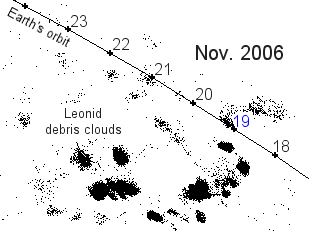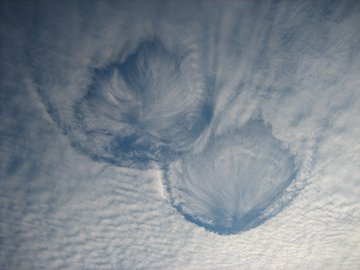 Autumn is here, and it's a wonderful time for stargazing. Find out what's up from Spaceweather PHONE.
Autumn is here, and it's a wonderful time for stargazing. Find out what's up from Spaceweather PHONE.
METEOR RADAR: The USAF Space Surveillance Radar is scanning the skies above the southern USA, pinging anything that flies overhead. This weekend, the radar's loudspeakers may be ringing with echoes from Leonid meteors. Click to listen: live audio.
LEONID METEORS: Every year in mid-November, Earth glides through a veritable minefield of comet dust clouds. The source: Comet 55P/Tempel-Tuttle. This weekend Earth will graze one of those clouds, producing an outburst of Leonid meteors.

If forecasters are correct, the outburst will peak around 0445 UT on Sunday, Nov. 19th (11:45 p.m. EST on Saturday, Nov. 18th). The timing favors observers in western Europe, Brazil and the Atlantic coast of North America, who could see as many as 100 meteors per hour: full story.
Although the shower is expected to peak sharply at 0445 UT on Nov. 19th, keep an eye on the sky at other times, too. Leonids may appear in fits and spurts all weekend long. The best time to watch, generally speaking, is during the hours before dawn when the constellation Leo is high in the sky: sky map.
HOLE PUNCH CLOUDS: The sky is full of mysteries, and one of them appeared over Wisconsin on Wednesday, Nov. 15th. "I live in Stevens Point on the University of Wisconsin campus, and I saw some very strange clouds," reports Samantha Weise who took several pictures:

more: #1, #2, #3, #4, #5, #6, #7
These are "hole punch clouds," and no one is certain what they are. One theory holds that they are formed by jet airplanes punching through a cirrocumulous cloud deck. When the jet pierces the cloud, supercooled water droplets in the cloud suddenly crystallize. This water-to-ice transformation proceeds outward from the point of impact, creating a vast circle of icy wisps--the "hole." But how many jets would it take to create this display? A mystery, indeed.
Readers, if you ever see a hole punch cloud in the act of opening, take pictures. You could help solve the puzzle of these beautiful formations.
UPDATE (Nov. 17): NASA and NOAA satellite images reveal that there were jets in the area on Nov. 15th. Apparently the jets themselves did not punch through the clouds, but particles in their exhaust may have fallen down through the cloud deck, creating the holes as described above: full story.

